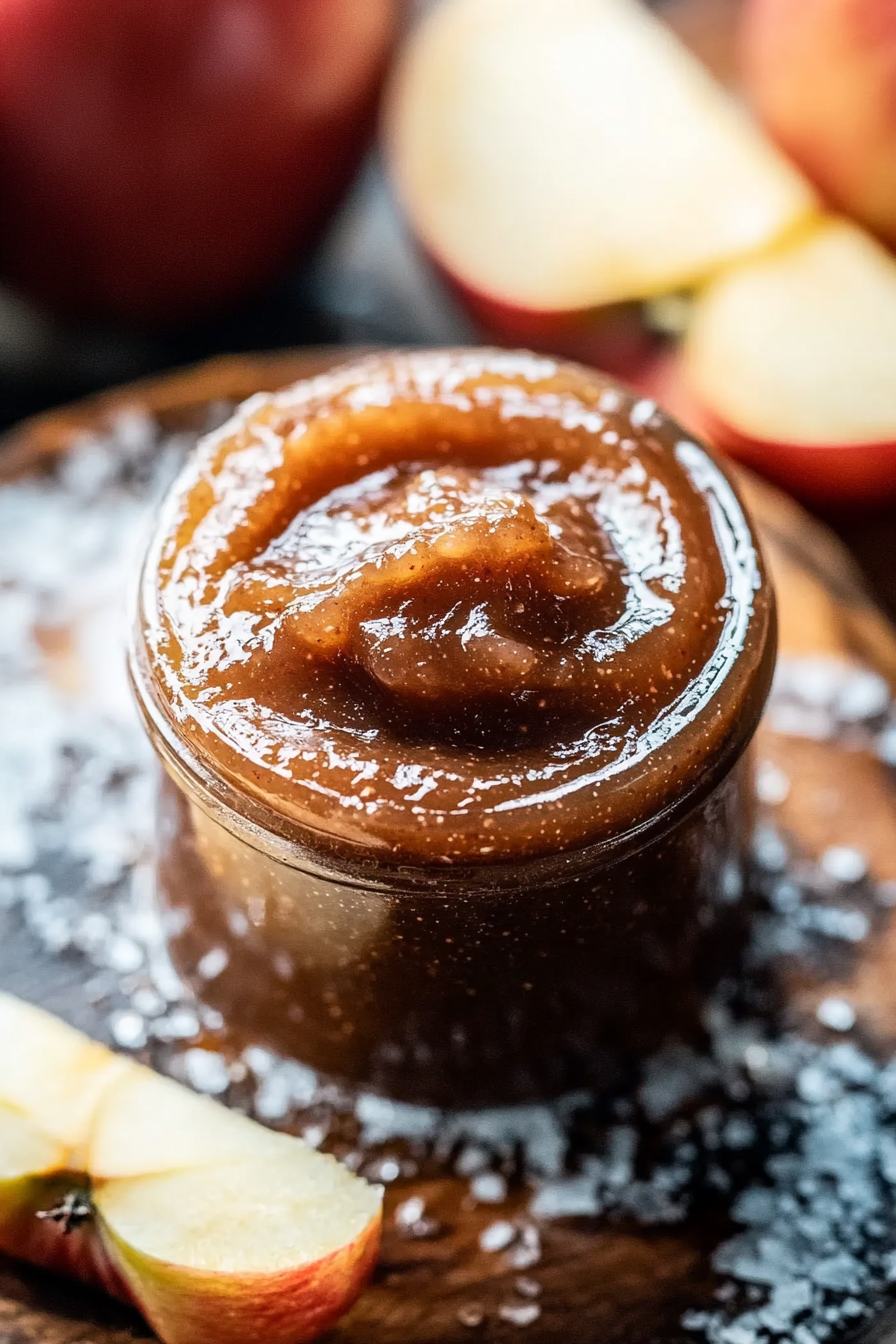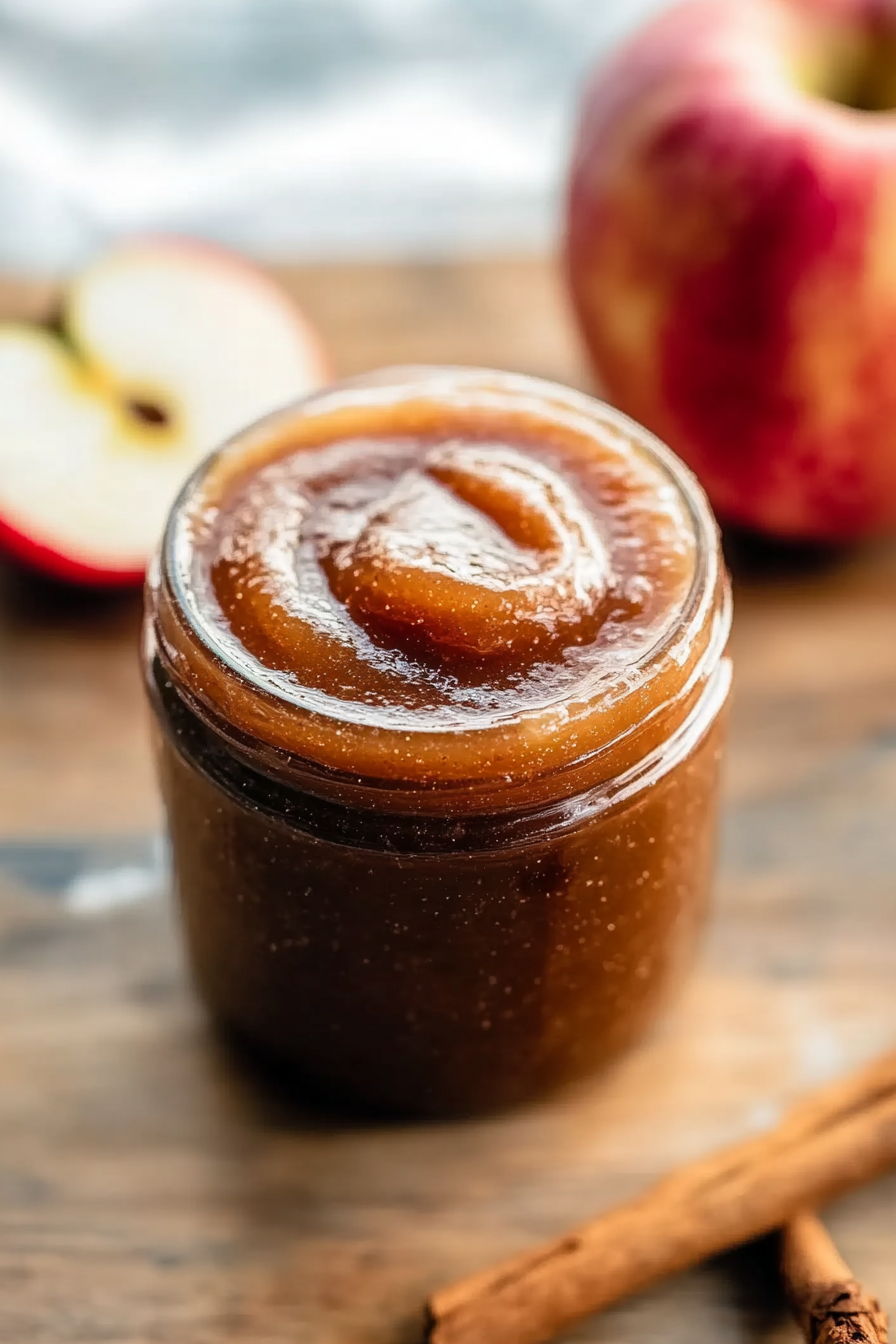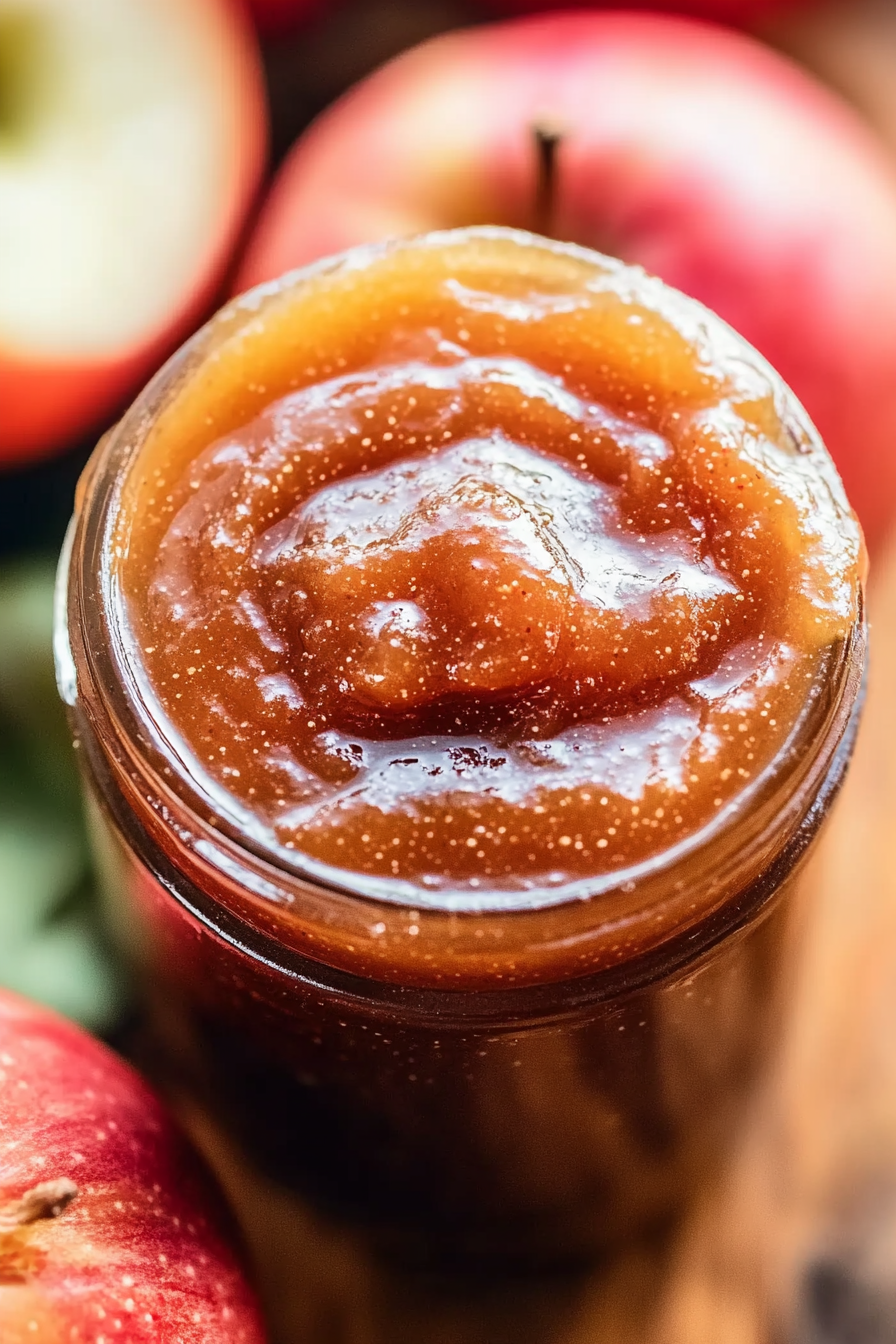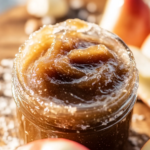Introduction to Apple Butter
Apple butter, a delectable spread reminiscent of autumn’s bounty, is cherished for its rich flavors and versatile uses. This apple butter recipe is a wonderful choice for home cooks and busy parents alike, as it marries simplicity with health-conscious ingredients. Being vegan and gluten-free, it promises a treat that’s accessible to all diets. With a medley of spices enhancing its natural sweetness, apple butter not only delights the palate but also offers a wholesome addition to breakfast or snacks. Discover the joy of crafting this delicious spread as you learn about its origins and uses in everyday meals.
Benefits and Advantages of Apple Butter
Apple butter stands out as a truly remarkable addition to any kitchen due to its ease of preparation and natural ingredients. This beloved spread offers not just delightful flavors but also numerous health benefits. Unlike traditional butter, apple butter is free from dairy, fat, and cholesterol, making it a guilt-free indulgence. It’s perfect for those with dietary restrictions, as it caters to vegan and gluten-free diets. Its versatility shines in countless recipes, from breakfasts to snacks, adding a unique touch wherever used. Experience the simplicity and pleasure of making apple butter while delivering a nutritious option for you and your loved ones.

Ingredients Overview
Essential Ingredients for Apple Butter
- 6 pounds of apples (use a mix of sweet and tart varieties like Fuji and Granny Smith)
- 1 cup granulated sugar
- 1 cup brown sugar (helps deepen the flavor)
- 2 teaspoons ground cinnamon (for warming spice)
- 1/2 teaspoon ground cloves (adds depth and balance)
- 1/2 teaspoon ground nutmeg
- 1/4 teaspoon salt
- 1 tablespoon vanilla extract (for a subtle vanilla note)
- 1/2 cup apple cider or apple juice (optional, for added moisture)
These ingredients shape a classic apple butter that is rich in flavor and perfectly smooth. For those conscious of dietary needs, ensuring that your apple butter remains vegan and gluten-free is simple: use only plant-based, gluten-free ingredients.
Dietary Substitutions to Customize Your Apple Butter
- For a sugar-free option: Use a natural sweetener such as honey, maple syrup, or a sugar substitute like stevia. Adjust the amount according to taste.
- To make it completely vegan: Ensure your sugar is certified vegan (check that it isn’t processed with bone char).
- Gluten-free adjustments: All the listed ingredients are naturally gluten-free, so you can enjoy this spread with peace of mind if you follow a gluten-free diet.
- Reduced calorie version: Use less sugar or sugar substitutes to cut down on calorie intake without sacrificing sweetness.
These substitutions allow you to tailor the apple butter to fit various dietary considerations while still maintaining that classic homemade taste. Feel free to experiment and find which combinations suit your palate the best.
How to Prepare the Perfect Apple Butter: Step-by-Step Guide
Creating apple butter is a rewarding process that fills your home with a delightful aroma. Follow these steps to craft a batch that’s absolutely indulgent.
- First Step: Start by washing, peeling, and coring your apples. Slice them into small chunks to ensure an even and quick cooking process.
- Second Step: Combine the apple pieces in a large pot, adding both types of sugar, cinnamon, cloves, nutmeg, and salt. Stir to evenly coat the apples with the sugar and spices.
- Third Step: Cook the mixture over medium heat. Initially, the apples will release moisture, preventing them from sticking. Stir occasionally to avoid burning, and cook until the apples start breaking down and softening.
- Fourth Step: Once the apples are soft and much of the liquid has evaporated, use an immersion blender to puree them until smooth. Alternatively, a regular blender can be used in batches.
- Fifth Step: Lower the heat and continue cooking the puree. Stir frequently to ensure it doesn’t burn, until the mixture thickens to a spreadable consistency, which may take an additional 1-2 hours.
- Sixth Step: Add the vanilla extract during the last 10 minutes of cooking, stirring it in thoroughly. This enhances the aroma and flavor.
- Seventh Step: To check if the apple butter is ready, place a small amount on a plate. If no liquid separates after a few minutes, it is done.
- Eighth Step: Transfer the hot apple butter into sterilized jars, leaving about a 1/4 inch of headspace, and seal immediately. This helps preserve the spread and keeps it fresh for months.
This process allows you to adapt the apple butter to your taste and dietary preferences while ensuring it remains a delicious treat. Enjoy it as a spread, an ingredient in cooking, or a thoughtful gift for others.

Mastering Apple Butter: Advanced Tips and Variations
Creating apple butter is an exercise in patience and a joy for the senses. Beyond the basic apple butter recipe, numerous advanced tips and variations can enhance your experience, offering distinctive tastes that will delight your palate. Here are some suggestions for enriching the depth and complexity of your apple butter.
Advanced Tips for Optimal Apple Butter
- Selecting the Right Apples: Choose a mix of sweet and tart apples for a balanced flavor. Varieties such as Fuji, Granny Smith, and Honeycrisp work exceptionally well.
- Adjusting Spices: Feel free to tweak the amount of your spices. Extra cinnamon or a touch of allspice can create a warm, comforting aroma.
- Blending Techniques: For ultra-smooth apple butter, use an immersion blender after cooking to break down any remaining chunks of apple.
Exciting Variations to Try
Transform your apple butter by experimenting with additions and tweaks to the traditional recipe:
- Vanilla Infusion: Add a vanilla bean pod during cooking for a sweet aromatic flavor.
- Spiked Apple Butter: Introduce a splash of bourbon or brandy during the last few minutes of cooking for an adult twist.
- Fruit Blends: Incorporate pears or cranberries for a unique fruity variation. This can be a wonderful way to use up any additional autumn fruits you might have.
By mastering these advanced techniques and experimenting with variations, you can create apple butter that caters precisely to your taste preferences, enhancing your culinary repertoire. Whether spread on fresh baked goods or used in cooking, homemade apple butter provides a versatile base for exploring flavors that evoke rich traditions and homey comfort.
How to Store Apple Butter: Best Practices
Proper storage of your apple butter ensures it stays fresh and flavorful for an extended period. From refrigeration to canning, understanding the best practices helps maintain the quality and taste of your concoction.
Refrigeration
After preparation, allow your apple butter to cool before transferring it into airtight glass jars or containers. Refrigerate it for up to three weeks. This keeps the spread fresher and prevents spoilage thanks to the lower temperatures.
Freezing
If you plan to store apple butter for a longer period, freezing is an excellent option. Transfer portions into freezer-safe, airtight containers, and ensure you leave about an inch of space at the top to allow for expansion. Properly frozen, apple butter can last up to a year.
Canning for Long-Term Storage
For those who wish to keep apple butter shelf-stable, canning is the way to go. Use sterilized jars and a water bath canning method to ensure all bacteria are eliminated. Properly canned apple butter can be stored at room temperature in a cool, dark place and enjoyed for several months, often spanning your entire holiday season.
Regardless of the method you choose, understanding these storage techniques will help keep your apple butter fresh and inviting, ready to deliver beautiful flavors whenever you wish to use it—whether in delicious recipes or as a simple spread on your morning toast.

Nutritional Value of Apple Butter
Understanding the nutritional value of apple butter can help you make informed dietary choices. This delicious spread, while predominantly a sweet treat, offers some nutritional benefits that contribute to a balanced diet.
| Nutrient | Amount per tablespoon |
|---|---|
| Calories | 30 |
| Total Fat | 0g |
| Cholesterol | 0mg |
| Sodium | 0mg |
| Total Carbohydrates | 8g |
| Dietary Fiber | 1g |
| Sugars | 6g |
| Protein | 0g |
Most of the calories in apple butter come from carbohydrates, primarily sugars. There is very little fat and no cholesterol, making it a suitable topping for those watching their fat intake. The lack of sodium adds to its appeal as a heart-friendly option, especially when compared to more processed spreads.
Including apple butter in your diet can offer a nice flavor change while adding a modest amount of fiber, thanks mainly to the apples used in its preparation. When consuming apple butter, keep in mind that portion size can impact the overall nutritional intake, especially concerning sugar levels. Exploring homemade apple butter options allows for a reduction in added sugars, providing a healthier alternative to commercial brands.
FAQs: Frequently Asked Questions About Apple Butter
- What is apple butter used for?
Apple butter is commonly used as a spread on toast, bagels, and muffins. It’s also delightful mixed into yogurt or oatmeal. Chefs might use it as a glaze or marinade for meats, enhancing the flavor with its sweet and spiced undertones.
- What is the difference between apple butter and applesauce?
While both apple butter and applesauce start with cooked apples, the primary difference lies in their texture and flavor. Apple butter is thicker and more concentrated due to prolonged cooking, often imbued with spices like cinnamon and cloves, giving it a richer taste. In contrast, applesauce is less concentrated, often lighter in spice, and has a more liquid consistency.
- Does apple butter need to be refrigerated?
Yes, after opening, apple butter should be refrigerated to maintain freshness and prevent spoilage. If unopened and properly canned, it can be stored at room temperature in a cool, dark place. When properly sealed and stored, apple butter can last many months in the refrigerator.
- How is apple butter made?
Apple butter is made by slowly cooking apples with sugar and spices until the mixture reduces to a thick, spreadable consistency. Traditionally, this was done in large copper kettles over an open fire, though modern methods often use crockpots or stovetops. The extended cooking time allows the apples to caramelize, deepening the flavor and darkening the color.

Apple Butter Recipe Spiced
- Total Time: 6 hours 20 minutes
Description
🍏 Slow-cooked to perfection, this rich and spiced apple butter is a delicious way to savor the flavors of fall while preserving apples naturally! 🍂
🥄 Spread it on toast, swirl it into oatmeal, or use it as a marinade—its warm, comforting taste makes every bite irresistible! 🍎
Ingredients
Apples
Sugar
Cinnamon
Cloves
Instructions
1. Select fresh apples and wash them thoroughly.
2. Peel, core, and chop the apples into small pieces.
3. Place the chopped apples in a large pot or slow cooker.
4. Add sugar, cinnamon, and cloves for flavor.
5. Cook the apples on low heat, stirring occasionally.
6. Let the mixture simmer for several hours until softened.
7. Mash or blend the apples to create a smooth consistency.
8. Continue cooking until the mixture thickens and darkens.
9. Taste and adjust sweetness or spices if needed.
10. Allow the apple butter to cool slightly before storing.
11. Transfer the apple butter into sterilized jars.
12. Seal the jars tightly for long-term storage.
13. Store in the refrigerator or properly can for shelf stability.
14. Use apple butter as a spread, in recipes, or as a sweetener.
Notes
Slow-cook apples with sugar and spices to achieve a smooth, spreadable texture.
Use a crockpot for a hassle-free cooking process that enhances flavor over time.
Store in sterilized jars to keep it fresh for months and enjoy year-round.
- Prep Time: 20
- Cook Time: 360
- Category: Spread
- Method: Slow Cooking
- Cuisine: American

